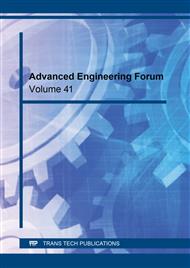[1]
J.B. Jones, Hydroponics; A Practical Guide for the Soilless Grower, Second Edition. CRC Press, United States of America, (2005).
Google Scholar
[2]
S. Nisha, A. Somen, K. Kaushal, S. Narendra, and O.P. Chaurasia, Hydroponics as an advanced technique for vegetable production: An overview. Journal of Soil and Water Conservation 17 (2018) 364 – 371.
Google Scholar
[3]
A.M Malik, K.M. Mughal and A.Saboor. Hydroponics production function, returns to scale and domestic resource cost in Pakistan, Pakistan Journal of Agricultural Research, 32 (2019) 449-455. DOI; http://dx.doi.org/10.17582/ journal.pjar/2019/32.3.449.455.
DOI: 10.17582/journal.pjar/2019/32.3.449.455
Google Scholar
[4]
H.M. Resh, Hydroponic Food Production; A Definitive Guidebook for the Advanced Home Gardener and the Commercial Hydroponic Grower Seventh Edition. CRC Press Taylor & Francis Groub. United States of America, (2013).
DOI: 10.1201/9781003133254
Google Scholar
[5]
S.V. Souza, R.T. Gimenes, E.Binotto. Economic viability for deploying hydroponic system in emerging countries: A differentiated risk adjustment proposal, Land Use Policy, 83 (2019) 357-369. https://doi.org/10.1016/j.landusepol.2019.02.020.
DOI: 10.1016/j.landusepol.2019.02.020
Google Scholar
[6]
Suhl, J., B. Oppedijk, D. Baganz, W. Kloas, U. Schmidt, and B.V. Duijn, Oxygen consumption in recirculating nutrient film technique in aquaponics. Scientia Horticulturae, 255 (2019) 281-291. https://doi.org/10.1016/j.scienta.2019.05.033.
DOI: 10.1016/j.scienta.2019.05.033
Google Scholar
[7]
Chun, C. and T. Takakura. Rate of root respiration of lettuce under various dissolved oxygen concentrations in hydroponics. Environ. Control in Biol. 32 (1994) 125-135.
DOI: 10.2525/ecb1963.32.125
Google Scholar
[8]
U. Subhan, V. Muthukannan, S.Y. Azhary, M.F. Mulhadi, E. Rochima, C. Panatarani, and I.M. Joni, Development and performance evaluation of air fine bubbles on water quality of thai catfish rearing. Citation: AIP Conference Proceedings 1927, 030043 (2018);.
DOI: 10.1063/1.5021236
Google Scholar
[9]
V. Thonglek, and K. Yoshikawa. Ultra-Fine Bubble Generators for Advanced Versatile Applications to Agriculture, Aquaculture and Food Safety. Proceeding International Symposium on Application of High voltage, Plasmas & Micro/Nano Bubbles to Agriculture and Aquaculture (ISHPMNB 2017), Rajamangala University of Technology Lanna Chiang Mai, Thailand, (2017).
Google Scholar
[10]
Serizawa, Fundamentals and Applications of Micro or Nano Bubbles. Proceeding International Symposium on Application of High voltage, Plasmas & Micro/Nano Bubbles to Agriculture and Aquaculture (ISHPMNB 2017), Rajamangala University of Technology Lanna Chiang Mai, Thailand, (2017).
DOI: 10.31276/vjste.63(3).42-47
Google Scholar
[11]
J.S. Park and K. Kurata, Application of Microbubbles to Hydroponics Solution Promotes Lettuce Growth. HortTechnology, 19 (2009) 212 – 215.
DOI: 10.21273/hortsci.19.1.212
Google Scholar
[12]
H. Ikeura, F. Kobayashi, and M, Tamaki, Removal of residual pesticide, fenitrothion, in vegetables by using ozone microbubbles generated by different methods, J. Food Eng. 103 (2011) 345–349.
DOI: 10.1016/j.jfoodeng.2010.11.002
Google Scholar
[13]
M. Takahashi, Base and technological application of micro-bubble and nanobubble. Mater. Integration 22 (2009) 2–19.
Google Scholar
[14]
M. Takahashi, ζ Potential of microbubbles in aqueous solutions: electrical properties of the gas–water interface. J. Phys. Chem. B 109 (2005) 21858–21864.
DOI: 10.1021/jp0445270
Google Scholar
[15]
K. Ebina, K. Shi, M. Hirao , J. Hashimoto , Y. Kawato , S.Kaneshiro , T.Morimoto, K.Koizumi, and H. Yoshikawa, Oxygen and Air Nanobubble Water Solution Promote the Growth of Plants, Fishes, and Mice. PLOS ONE, 8(2013) 1–7.
DOI: 10.1371/journal.pone.0065339
Google Scholar


